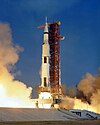|
Jarvis (rocket)
Jarvis was a proposed American medium-lift launch vehicle for space launch, designed by Hughes Aircraft and Boeing during the mid-1980s as part of the joint United States Air Force (USAF)/National Aeronautics and Space Administration (NASA) Advanced Launch System (ALS) study. Intended to utilize engines and tooling in storage from the Saturn V rocket program along with Space Shuttle components, and projected to be capable of carrying up to six satellites into multiple orbits using a single launch (e.g. GPS constellation), the proposal failed to meet the ALS requirements, and the Jarvis rocket was never built. HistoryJointly proposed by Hughes and Boeing as a heavy-lift rocket, using propulsion systems and equipment built for the Saturn V rocket and placed in storage at the end of the Apollo program,[1] as well as Space Shuttle components,[2] Jarvis was intended to be capable of launching multiple GPS satellites,[3] major components of the planned Space Station Freedom and commercial satellites.[1] The rocket was named after Hughes employee and NASA mission specialist Gregory Jarvis, who died in the Space Shuttle Challenger disaster in January 1986.[1] Submitted as part of the Advanced Launch System studies jointly conducted by the United States Air Force and NASA for a new heavy-lift rocket system capable of substituting for the Space Shuttle and expanding upon its capabilities,[4] Jarvis was planned as a three-stage rocket capable of launching a payload of up to 83,000 pounds (38,000 kg) to low Earth orbit, or 28,000 pounds (13,000 kg) to geosynchronous orbit; the rocket was projected to cost under $300 million USD per launch;[5] some estimates had a per-launch cost of the Jarvis vehicle at a cost as low as $150 million each, with $1 billion being cited as the projected development cost of the rocket system.[6] The first stage of the Jarvis vehicle was designed to use two Rocketdyne F-1 engines, powered by RP-1 rocket fuel and liquid oxygen (LOX); these were the same engines used by the Saturn V's first stage. The second stage would use a single Rocketdyne J-2 LOX/liquid hydrogen (LH2) engine, while the third stage was intended to utilise eight Marquardt R-4D reaction control system thrusters, fueled by a hypergolic mix of nitrogen tetroxide and monomethylhydrazine (N2O4/MMH), to provide final boost, and to allow for the deployment of multiple payloads into different orbits.[5][7] Jarvis was designed to be capable of carrying payloads of up to 26 feet (7.9 m) in diameter; as many as six satellites could be carried on a single rocket,[8] and it was suggested that the Global Positioning System (GPS) constellation be deployed in this manner.[9] While the Hughes proposal for the "Jarvis" would have been powered by a pair of Saturn V F-1 engines, when Boeing joined the proposal they quickly shifted the proposal toward a Shuttle-derived in-line design consisting of an External Tank powered by a single aft-mounted Space Shuttle Main Engine (SSME) augmented by a pair of Solid Rocket Boosters. This Revised Jarvis would be able to lift 80,000 pounds (36,000 kg) to LEO.[3] Although Hughes received an Air Force contract to study the Jarvis vehicle,[7] the Jarvis failed to meet the Air Force's requirements for the ALS, being too large in size compared to the specification.[10] In 1986, Hughes stated that the rocket could be operational by the 1990s,[7] with launches beginning two years after project go-ahead;[11] however the U.S. Air Force rejected the Hughes-Boeing proposal.[12] Consideration was given to continuing the Jarvis project as a private venture,[12] and the Jarvis was mentioned as meeting the requirements for a launch vehicle to be used in the establishment of a lunar base in a 1992 conference on the subject,[13] however nothing further came of the proposal, while the entire Advanced Launch System development effort was scaled back into the National Launch System before being cancelled in 1992.[14] See alsoReferences
External links
|
||||||||||||||||||||||||||||||||||||||||||||||||||||||||||||||||||||
